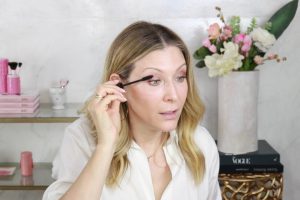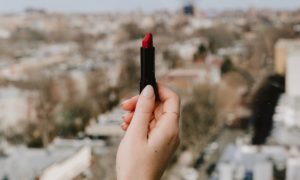Not all skin is created equal. By understanding *your* skin type, you can better address your skin concerns and properly care for it, which helps to maintain healthy skin in the long run. In our Genetic Skin Types series, we’ll be taking a closer look at the most common skin types and how to build your healthy skin routine accordingly.
Do you keep blotting papers in your bag? Have you ever tried to edit out the light reflecting off your skin in any given photo? If so: Shiny foreheads, unite! That’s the usual territory of those with naturally oily skin, which — as with any skin type — comes with some pros and cons.
Fortunately, the source of oily skin is refreshingly simple: Your skin just churns out a lot of oil. And while that means that your skin will never be parched, unlike those with dry skin, it can come with a few considerations.
Here’s what you should know to balance things out.
What causes oily skin?
As we mentioned: oily skin just means your skin produces higher-than-average amounts of oil, or sebum. To get really specific with you: “With oily skin, the sebum production averages 1.5 to 4.0 mg per 10 cm2 every 3 hours,” says NakedPoppy research scientist Marisa Plescia. For context, compare that to people with dry skin, which clocks in at a mere 0.5 mg per 10 cm2 in the same time, or normal skin, which comes in at 1 mg/10 cm2.
If your skin is chronically oily, you can go ahead and blame it on your genetics — that’s a given. Other factors can contribute to oiliness too, such as changes and imbalances in hormones (explaining why you might’ve been extra oily in high school), certain medications, and even stress.
If your skin is oily, you’ll be able to see it. Your skin will be oily from morning to night, possibly with a little respite right after cleansing, says NakedPoppy skin specialist Tara Parenti.
What are the signs of oily skin?
“Oily skin is often characterized by large and clearly visible pores and a glossy shine,” says Plescia. That could ultimately lead to acne, as “the excess oil production and dead skin cell build-up is the ideal food source for bacteria to grow and thrive,” says Parenti.
Along with the potential for breakouts, oily skin type is more prone to blackheads and congestion. But before you start to stress, take heart: Oily skin doesn’t necessarily mean you’re destined for adult acne. Your skin’s potential for acne depends more on the quality of the sebum versus the quantity. If it’s more “fluid,” says Plescia, it won’t clog the pores.
There’s also an upside to oily skin. “Oily skin type tends to be more resilient because the excess oil produced is providing lubrication to the skin,” says Parenti. “Lines and wrinkles look much less prominent.” Since skin gets drier as it matures, people with oily skin have a built-in buffer against that.
How to treat oily skin
First, quit trying to make your pores disappear. You can blur them with makeup all you want, but actually shrinking them is A) not possible, and B) doing more harm than good for your skin. “We cannot change the size of our pores,” says Parenti. The idea of them opening and closing is outdated and inaccurate.
And trying to obliterate your pores and scrub off the oil will only be counterintuitive. “A little known, yet important contributing factor to oily skin is oftentimes, people with oily skin over-cleanse and under-moisturize,” says Parenti.
The thinking behind that isn’t totally backwards; if you have enough oil, it makes sense that you wouldn’t necessarily want to introduce more. But skin is more nuanced than that. “When the skin barrier is deprived of healthy lipids, the sebaceous gland will produce excess oil to overcompensate for the lack of moisture,” explains Parenti. “Harsh cleansers and toners and not skipping your moisturizer can have an adverse effect on this skin type.”
The bottom line: Be kind to your oily skin. As time goes on, it’ll come in pretty handy.
The ideal skincare routine for dry skin
- Cleanse: While cleansing skin at night with an oil cleanser benefits pretty much everyone, it’s especially beneficial for those with oily skin. “Like attracts like,” explains Parenti. “Oil cleansing helps to effectively break down excess oil production, as well as oil- based dirt and debris—like makeup and physical SPF—while still maintaining the integrity of healthy lipids and barrier function.” Then, follow up with a foam cleanser, which contains surfactants that draw oil out of skin. “Plant-based surfactants are gentle and won’t strip the skin barrier,” says Parenti. A safe bet: NakedPoppy Refresh Foam Cleanser, which purifies skin while supporting the skin barrier.
- Tone: These tend to give you the best of both worlds: You’ll get humectants, which draw water into skin — necessary even if you’re all set on oil — as well as astringents to gently remove excess oil. Parenti recommends Ere Perez Herbal Face Tonic, which has salicylic acid-rich witch hazel.
- Exfoliate: Exfoliating is essential for oily skin, as the combo of dead skin cells, oil, and bacteria can lead to breakouts. Parenti recommends beta hydroxy acid, or salicylic acid, to help decongest skin, while azelaic acid is a winner for more sensitive skin. Try the Maya Chia Refresh Mint Resurfacing Moisture Mask or KYPRIS Clearing Serum.
- Moisturize: Surprise! You still need to moisturize even if your skin is oily — so as to not kick off the cycle of drying out skin and triggering even more oil production. With that in mind, “Lightweight, non-comedogenic, and easily absorbed moisturizers are best for oily skin types,” says Parenti, who’s a fan of Indie Lee Active Oil-Free Moisturizer. “A formulation like this will provide ample hydration, while not adding any additional oil to the skin.”
You could also try adding more oil particularly those rich in fatty acids, to balance skin. “Using an appropriate blend of oils can help to balance oil production and can provide natural antibacterial and astringent properties,” explains Parenti. One such example is NakedPoppy Revitalize Organic Facial Oil, which helps replenish certain fatty acids and balance sebum production.
If you’re looking for a full routine, head over to the 3-min NakedPoppy assessment, which will automatically match you with the ideal skincare products for your skin type, including oily skin. And if you haven’t yet, consider tweaking your perspective to see oily skin as the boon that it is. It may take awhile for its perks to take center stage, but the wait is worth it.






Comments